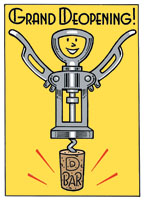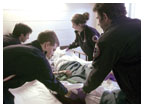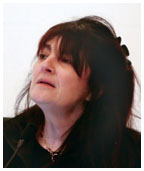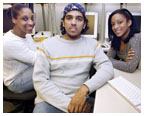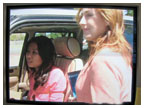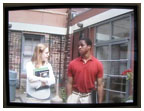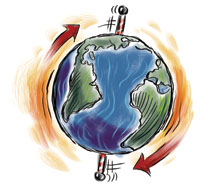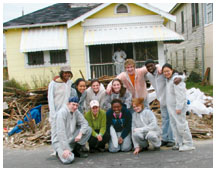
|
April 4, 2007: Notebook
DBar fans: Deplace is delightful
Student EMTs answer the call for town squad
Robertson case: $782,375 repaid
‘We got guts’ campaign seeks help for New Orleans
Theme of black men’s caucus: ‘Improve our status’
The top 10 universities are rated in six “aggregated fields” of study: Princeton ranked fifth in language and literature, eighth in computer and information science, and ninth in philosophy and religious studies. The index rates the “productivity” of faculty members on the basis of publications, grants, and awards and honors. The index is reported as a z-score, a statistical measure in which zero means the program is at the national mean for the discipline; a score of 1.0 means the program is one standard-deviation unit higher than the national mean.
Source: 2005 Faculty Scholarly Productivity Index data provided to The Chronicle of Higher Education |
Dean
questions new graduate program rankings
Index assesses doctoral programs on the basis of faculty productivity
A new system of rating graduate programs based on faculty productivity ranks Princeton 12th among 166 large research universities, but Graduate School Dean William Russel questions the ratings’ reliability.
The ratings, called the Faculty Scholarly Productivity Index, were developed by Academic Analytics, a company partly owned by the State University of New York at Stony Brook and by Educational Directories Unlimited, which owns the Web site GradSchools.com. Faculty are measured on publications, federal grants, and honors and awards. Harvard and Caltech ranked first and second overall.
Using 2005 data, the index ranked 23 Princeton programs and departments in the top 10 nationally. Four — English, history, Near Eastern studies, and aerospace engineering — were ranked No. 1 in their fields. (Princeton’s program combines mechanical and aerospace engineering.) The philosophy and electrical engineering departments were ranked No. 2; astrophysical sciences was ranked No. 3.
In an interview with PAW, Russel expressed concern about the survey data. “They don’t have accurate numbers,” he said, noting as an example that Near Eastern Studies, for which Academic Analytics lists 26 faculty, includes eight lecturers with little involvement with the graduate program. Russel said the University has been working for a year to compile data for the National Research Council, often referred to as the “gold standard” of graduate program assessments, which is expected to release an update of its 1995 doctoral program rankings by the end of this year.
The dean also questioned the calculations used to produce the index, saying that the algorithm has not been defined publicly. Overall, he termed the ratings “erratic,” adding that Princeton departments generally rank “rather well, though not that consistently with perceptions from faculty and graduate student recruiting.” While Princeton has no doctoral program in Portuguese, it is ranked No. 4 in that category, he noted.
Russel’s statements were supported by Jon Butler, dean of Yale’s Graduate School of Arts and Sciences. Not only does Academic Analytics use untested methodology, Butler told PAW, but conflict-of-interest questions are raised by the role played by the dean of Stony Brook’s graduate program, Lawrence B. Martin. Martin is a co-owner with Stony Brook of Academic Analytics, a for-profit company, and Stony Brook itself is rated by the index.
Martin said the company has been open about its ownership and has explained in detail on its Web site how its survey is derived. The company relies on lists of faculty published by colleges and universities, he said, and departmental faculty lists were sent to each institution for review and correction. Butler and Russel said that ensuring accuracy is difficult and expensive, and a commercial venture like Academic Analytics should bear the cost of obtaining clean data.
In looking at Princeton’s rankings across all its doctoral programs, Martin said the survey found that some departments are “as good as it gets, but it’s not uniform across the board.”
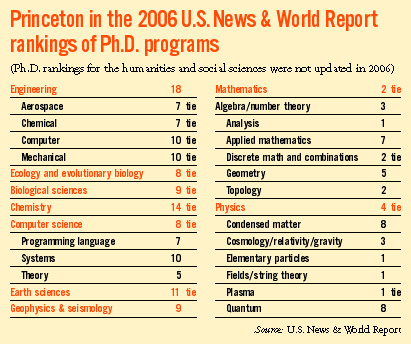
Describing the index as “a set of tools,” he said he hoped that universities would use the findings to “improve institutional performance.”
Jeremiah Ostriker, professor and former provost at Princeton, chairs the committee charged with producing the NRC’s upcoming survey. While graduate education is “greatly underassessed,” he said, rankings like Academic Analytics’ should be viewed with caution because of three factors: inherent statistical uncertainties, input data that often is flawed, and measurement criteria that can reflect arbitrariness and biases. “If you put these together, each one adds an element of uncertainty,” Ostriker said.
Both Russel and Butler said they have more confidence in the annual U.S. News & World Report rankings of graduate schools. U.S. News released new rankings of departments in the physical and natural sciences in 2006; departments in the humanities and social sciences were last ranked in 2005.
In determining how its graduate programs compare to other schools, Russel said, the University looks at how well it competes for faculty hires and for graduate students who have applied to Princeton and to other top schools. In addition, departments are periodically reviewed by committees of peers at other universities, he said.
In 2006, the Graduate School’s major competitors for accepted Ph.D. candidates were MIT, Stanford, and Harvard for the natural sciences, engineering, and architecture. For the humanities, social sciences, and the Woodrow Wilson School, the major competitors were Harvard and Yale.
The Graduate School also looks at Ph.D. placements, Russel said, noting
that “fewer than 10 percent of Ph.D.s tell us they don’t have
a job” when they leave the University. ![]()
By W.R.O.

(Ron Barrett) |
DBar fans: Deplace is delightful
The DBar — a fixture of the Graduate College social scene despite its water-stained walls, poor lighting, and holes in the floor — has reopened after eight months of sprucing up, and the reviews are positive.
“They’ve really made the DBar a more classy place,” said Donna Sy GS, chairwoman of the Graduate College House Committee. “Before it had more of a grungy basement feel.”
The floor and ceiling were replaced, the walls were waterproofed and now feature exposed brick and a built-in TV area, and the social lounge has been licensed to serve alcohol, providing a larger space for parties. In addition, access for the disabled was provided for the bar, which is located in the basement of Pyne Tower.
“It’s a more inviting and welcoming place,” said Lisa Schreyer, assistant dean.
Sy praised the commitment of William Russel, dean of the Graduate School, in obtaining the necessary funds for the project. “This attests to his commitment to grad students,” she said. “He sees our life at Princeton as a high priority.”
Russel said more than $2 million has been spent on improving facilities
in the basement level of the Graduate College, including the DBar work,
renovations to the laundry and porter’s lodge, and the design of
additional projects. ![]()

Preparing to move a nursing-home patient onto a stretcher are, from left, Max Freeberg ’08, Ben Easter ’07, Jessica Fleitman ’07, and Jacob Bregman ’06. (courtesy Princeton First Aid and Rescue Squad) |
Student EMTs answer the call for town squad
Ben Easter ’07 is always on call. As a student volunteer for the Princeton First Aid and Rescue Squad, Easter is never far from a radio that would alert him to a 911 call for help. If he is needed, he heads for an ambulance at the squad’s headquarters on Harrison Street, seasoned by 120 hours of EMT training and three years of experience with the squad.
About 30 students serve on the first aid squad, which answers about 2,500 calls a year. Students make up a majority of the squad’s members, and their duties are indistinguishable from those of local residents. Volunteers typically put in more than the required 42 hours per month on call at the squad building; senior members like Easter who are certified to drive the ambulance are expected to be on call virtually around the clock.
“It really helps you to realize that life does not revolve around the academic calendar,” Easter said. “Just because the University is on fall break, [or] because it’s the night before one of my finals, doesn’t mean the calls stop. We’re equal members in the squad with the people in town, and just because there’s something big on campus doesn’t mean we don’t have our responsibility to help the squad and the town.”
Serving on the Princeton EMT squad forges an unusual bond between town and gown. Besides 911 calls, the squad does “standbys” for University and high school football games, assists the fire department, and is available for major events during Reunions and Commencement, when Princeton is flooded with visitors.
According to Mark Freda, the president of the squad, students became a majority of the volunteers about 25 years ago. “When the scales seemed to tip from community members to University students, some people were concerned about that,” Freda said.
“But over time, it was proven that it wasn’t a concern. It was, in fact, the best thing that ever happened to us, because without that influx of students, the squad wouldn’t be able to exist right now.”
A member of the varsity women’s crew as a freshman, Elissa Furutani ’07 was no stranger to commitment when she joined the first aid squad as a sophomore. Furutani said her squad duties are more flexible than a varsity sport, though she may work for longer periods of time — she sometimes is on call at the station for 16-hour periods.
“It’s such a challenge, and it’s completely new every day,” Furutani said. “It’s great to just remind yourself of what’s important and actually feel like you’re making a difference.”
Members of the squad, students and townspeople alike, are brought together by the intensity of their experiences. “There’s a lot of teamwork involved on a call,” Easter said. “If it’s something like a vehicle rescue, you can be working in fairly dangerous situations as well, so you really have to come to know and trust the members on the crew.”
Furutani said that while the student volunteers don’t always socialize together on campus, their support can be welcome after a particularly stressful call. “It’s hard to go back to school when you’ve just [handled] a cardiac arrest,” she said.
Former squad chief Greg Paulson ’98 has been a Princeton EMT since his undergraduate days. Paulson made emergency medical services his career, working at Somerset Medical Center.
“The reason I decided to stay in Princeton was that I felt like I was part of a town,” Paulson said. “And that connection came almost completely from being on the squad.”
Furutani’s experience has influenced her career plans as well.
A history of science major who originally planned to pursue research,
she found that she was more interested in patient care and is planning
to attend medical school next year. ![]()
By Jocelyn Hanamirian ’08

Ruth Reichl (Photo by Hyunseok Shim ’08) |
“The latest elite food movement makes food look like anything but. Andy Warhol showed we have turned our food into symbols. We’re there now, but this highly decorative food goes out of style. ... Look for a pig’s head on your plate in the near future.”
Ruth Reichl, editor-in-chief of Gourmet magazine, author, and
former restaurant critic for The New York Times, in her talk
“Watch What You Eat” on March 6 in McCosh 50. Reichl was this
year’s J. Edward Farnum lecturer in the University’s Public
Lecture Series. ![]()

Robertson case: $782,375 repaid
The University last month repaid the Robertson Foundation $782,375 for a three-year program to assist graduate students, saying that foundation trustees had not been notified properly of the University’s plans.
The Graduate Funding Agreement, which partially supported 34 graduate students from 2000 to 2002, had been frequently cited by the Robertson family in its lawsuit against the University that seeks to regain control of the foundation’s funds.
The University notified foundation trustees and New Jersey Superior Court Judge Neil Shuster March 12 of the decision to reimburse the foundation. As of that date, Shuster had not ruled on a series of pretrial motions that were argued in November.
“We hope this demonstrates to the judge our commitment to good governance and good stewardship,” said University spokeswoman Cass Cliatt ’96.
The Graduate Funding Agreement was proposed by a former dean of the Woodrow Wilson School, Michael Rothschild, as a way to strengthen the school’s faculty by adding doctoral students in the economics, politics, and sociology departments. Dean Anne-Marie Slaughter ’80 discontinued the program in 2002.
The University said that the spending had been “plainly authorized” by the foundation’s charter, but that the money had been repaid “solely because of the inadequate disclosure of the agreement to the foundation board.”
Ron Malone, a lawyer for the Robertsons, termed the reimbursement “too little, too late,” saying the University’s payment came without an apology and without interest on the funds.
The Robertson Foundation oversees the gift of $35 million made by Marie
and Charles Robertson ’26 in 1961 to expand the Wilson School’s
graduate program. The value of that gift has since grown to more than
$800 million. ![]()
By W.R.O.

Natalia Naman ’08, right, writer and producer of a student TV drama called Varsity, with film editors Zennen Clifton ’08, center, and Ariel Rogers ’08.
Scenes from the first episode. (Frank Wojciechowski, left; courtesy Natalia Naman ’08) |
Now
showing: A TV soap opera, Princeton-style
What do you get when a black high school student from the wrong side of the tracks accidentally reveals that the mayor’s daughter, a white cheerleading captain at a rival school, is his half-sister? Drama. Or to be more precise, “high school melodrama, bordering on soap opera,” according to Natalia Naman ’08, the writer and producer of Varsity, an original television show broadcast to campus dorm rooms on the Princeton Student Television Network (PSTN).
In Varsity, students at two high schools are separated by race and class but linked by a heated football rivalry. The real action takes place away from the gridiron, in a set of intertwined relationships and tense hallway encounters that emulate Dawson’s Creek, the film Mean Girls, and a few firsthand memories. “The show was inspired by my high school,” Naman said, “but I think in any high school you get those kinds of experiences.”
PSTN, which launched in April 2006, was looking to add a drama series to its lineup, so Naman, an English major and theater-certificate student from Columbus, Ga., dusted off a handful of scripts that she had started writing before she came to Princeton. She recruited a cast of about 20 undergrads, and began rehearsing and filming the first episode in the fall.
Naman’s first challenge was finding high school backdrops on a collegiate gothic campus. She shot scenes in front of the music department’s lockers in the basement of the Woolworth Hall, on the bleacher seats at Class of 1952 Stadium, and inside the living room of a Spelman suite. After shooting, she turned to friends Ariel Rogers ’08 and Zennen Clifton ’08, who took on the tedious task of editing the scenes down to two half-hour episodes. (A third is coming in April or May, Naman said.)
Naman said she was nervous when Varsity held its debut party
at Frist Campus Center in February, but the 50 or so students who watched
the first episode calmed her fears. “People were laughing,”
she said, “in a good way.” ![]()
By B.T.
MORE ON THE WEB: View a video clip from Varsity’s first episode:
Small format .mov file (1.6 MB)
Medium format .mov file (2.1 MB)
Large/iPod format .mov file (18 MB)
Many browsers will automatically begin playing movies with Quicktime or RealPlayer. For help on downloading plug-ins to view movies, click here.

(Steven Veach) |
Full Tilt
Could a massive change in geography alter Earth’s weight distribution enough to change the axis on which it spins? One Princeton researcher writes that it not only could happen but that it probably did — about 800 million years ago. Adam Maloof, an assistant professor of geosciences, and five colleagues found evidence of a possible “polar wander event” in the orientation of magnetic particles in sediment from East Svalbard, Norway. The location of Earth’s magnetic poles shifted as much as 55 degrees, according to their findings, published in the September–October issue of the Geological Society of America Bulletin. Maloof and his colleagues plan to study other sediments from the same period of geologic history in different regions to corroborate their data.
To surf and protect Coral reefs can act as buffers and reduce the impact
of tsunamis, according to a study by Princeton researchers published in
Geophysical Research Letters last December. A reef within a meter
or two of the ocean’s surface located at least a few hundred meters
from shore can cut a tsunami’s run-up on land by up to one-half,
compared to shorelines not protected by reefs. But reefs degraded by human
activities like fishing and channel building could prove less effective,
say authors Catherine Kunkel ’06, Professor Michael Oppenheimer,
and Robert Hallberg of the Princeton-based Geophysical Fluid Dynamics
Laboratory. Reef health is an important factor, they write, because live
coral increases the drag that a reef exerts on a wave. ![]()

Students who gutted homes in New Orleans during intersession included, kneeling from left, Conrad Legendy ’07, Jennifer Scott ’07, Abena Mackall ’09, and Farrell Harding ’10, and standing from left, Veneka Chagwedera ’09, Aita Amaize ’07, Emery Whalen ’09, Libby Hutton ’09, David Christie ’10, Colton Heward-Mills ’10, and Cindy Hong ’09. (Courtesy Farrell Harding ’10) |
‘We got guts’ campaign seeks help for New Orleans
New Orleans native Emery Whalen ’09 wears her civic pride on her sleeve — or, to be more accurate, on her ears, which hold a pair of dangling silver fleur-de-lis earrings. So when she had a chance to study her hometown and the effects of Hurricane Katrina in a politics class last fall, she jumped at the opportunity.
The course, taught by associate professor Melissa Harris-Lacewell, covered everything from political history and race relations to environmental issues in New Orleans, preparing students to think about the city’s long-term future. But Whalen and some of her classmates wanted to be part of the short-term solution as well.
During intersession, 13 undergraduates from the course traveled to New Orleans to help remove drywall and debris from homes that had been collecting mold for more than a year. In one week, the students managed to work their way through about six houses. “When you finish gutting a house, you feel so proud,” said Farrell Harding ’10, another New Orleanian who was part of the class. “But then you look down the street and see a hundred houses that haven’t been touched. ... It was sort of depressing.”
Whalen and Harding decided to build on their intersession experiences, launching a Web-based grassroots campaign (www.wegotguts.com) to encourage legislators and presidential candidates to visit New Orleans, see the devastation that remains, and lend a hand by gutting a house or two. The campaign, called “We Got Guts,” has drawn support from student letter-writers and some alumni, Harding said, and though it has not caught on with legislators on Capitol Hill, the organizers are continuing their efforts.
“We’re not asking for any specific legislation,” Whalen
said. “We’re just hoping that once they have witnessed and
experienced what the situation is like in New Orleans, they will go on
and make their own choices to implement better policy.” ![]()
By B.T.

Theme of black men’s caucus: ‘Improve our status’
More than 250 college students gathered on campus March 3 for a conference on issues facing black men in America, where participants heard repeated calls to take responsibility for change in the African-American community.
“The conference definitely got the ball rolling on discussing activism locally and globally,” said Myra Safo ’09. Discussions “had a frank and open atmosphere that allowed a lot of taboo issues to be broached,” she said.
Chris Chaney ’07, one of the organizers of the conference, said it grew out of the mission of scholarship and service of the Black Men’s Awareness Group, an organization of undergraduate and graduate students that started the event last year as part of its “State of Black Men in America” initiative.
“I felt that a black men’s conference at an Ivy League institution such as Princeton was well overdue, especially considering the tremendous black scholars we have here,” Chaney said.
Conference panels addressed themes of black men and religion, black professionals, family life, mental health, sexual health, and education. Scholars, civic leaders, community activists, and religious leaders took part in the discussions.
“What black men really need is a new marketing agency. The world sees us as a problem,” said Kevin Williams ’83, a child psychiatrist who spoke during a panel on black men and mental health. “As black men we need to concentrate on improving our status.”
The keynote address was given by writer and activist Herb Boyd, who urged the participants not to dwell on “the misery index and the gloomy report,” referring to statistics suggesting that black men fare much worse than other races using indicators such as living in fatherless homes, suicide rates, and incidence of AIDS. “Let’s talk about the positive aspects and certainly about what can be done,” Boyd said.
Chaney said he thought the conference achieved its goal of serving as a forum for pressing issues and encouraging participants to address those issues in their communities.
“One of the overarching themes was probably empowerment —
empowerment in a sense of looking at black men in a positive light,”
he said. ![]()
By Alex Gennis ’09


